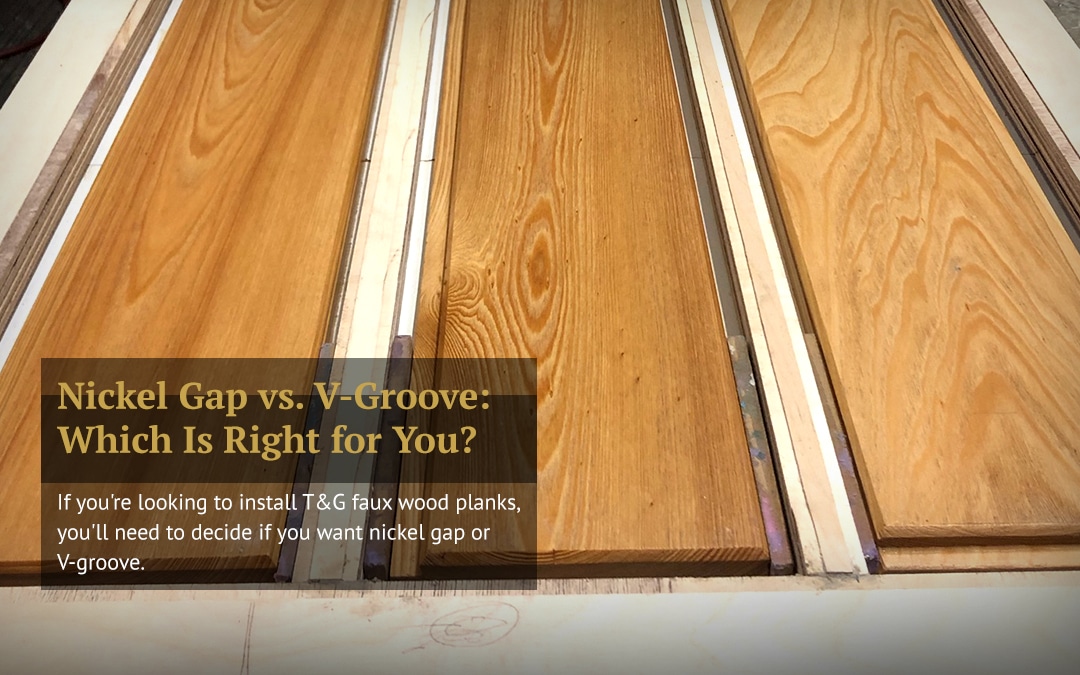Tags: Ceiling Beams, Decorative Wall Panels, Nickel Gap, Tongue and Groove, Tongue and Groove Ceiling
Tongue & groove faux wood planks are an impeccable way to beautify your home. And considering so many people are becoming new homeowners, there’s no better time to make these changes!
But as you’re looking through different types of faux wood planks, you’re likely seeing different groove types for these planks. Nickel gap, v-groove, shiplap, what’s the difference between them all?
In this article, we’ll cover these differences, which is best for you, and where you can get amazing T&G faux wood planks.
Let’s dive in.
V-Groove Faux-Wood Planks
Understandably, there’s some confusion surrounding V-groove faux wood planks and comparing them with shiplap. We’ll clear that up first.
To begin, both have tongue & groove systems. This means they have interlocking edges that help pieces ‘click’ into place during installation.
Both are easier to install than wood flooring (which is exploding in price) due to their systems, but the difference comes in their interlocking designs.
Shiplap’s tongue & groove system has a curved edge to it that overlaps with its adjacent pieces. This can help with water resistance but naturally means there are more pieces required to cover a surface.
V-groove (or V-jointed) doesn’t have this curve. It offers a flatter cladding face, creating less overlap between pieces. A slope at the edge of the piece leans inwards to the next piece, creating the ‘V’ profile the name is known for.
Because these pieces have less overlap you need less of them to cover an entire surface. The texture can be noted when looking or feeling these pieces, but in the end, their stylistic differences are minimal.
Nickel Gap Faux-Wood Planks
Now unlike v-groove or shiplap, the connections on nickel gap faux wood planks don’t run flush. As the name suggests, there is a small gap between planks upon installation.
This gap is roughly 1/8″, or close to the width of a nickel. Unlike the previous groove types, nickel gap requires a bit more work in the installation process, usually requiring manual spacers to get the gaps perfectly spaced.
The purpose is made clear at the end of the installation. These gaps are large enough to have nails go between them. Thus, the nails aren’t showing on your boards and won’t need to be covered over with putty, paint, or caulk later.
Some faux wood planks, particularly those that are darker in color, can get away without filling in these holes. But in white or lighter colored planks, it’s absolutely essential.
That’s why nickel gap looks spectacular for ceiling styles and different walls. You don’t need to worry about nail holes showing.
For flooring, however, you might be best suited to go for the v-plank option, as traditionally flooring doesn’t need to be nailed in and won’t have that issue.
Purchase Tongue & Groove Faux Wood Planks
Knowing the differences between nickel gap and v-groove planks can save you some time and energy as you’re constructing your perfect space.
Questions or concerns? We’re here to help.
Diamond Resin Products offers both types of tongue & groove faux wood planks. With tons of customization, including different plank lengths, styles, and cuts, we’re your go-to place for custom faux wood planks.
Order yours today, or if you’re in the Fort Myers area, come and visit us to check out our options in person.

